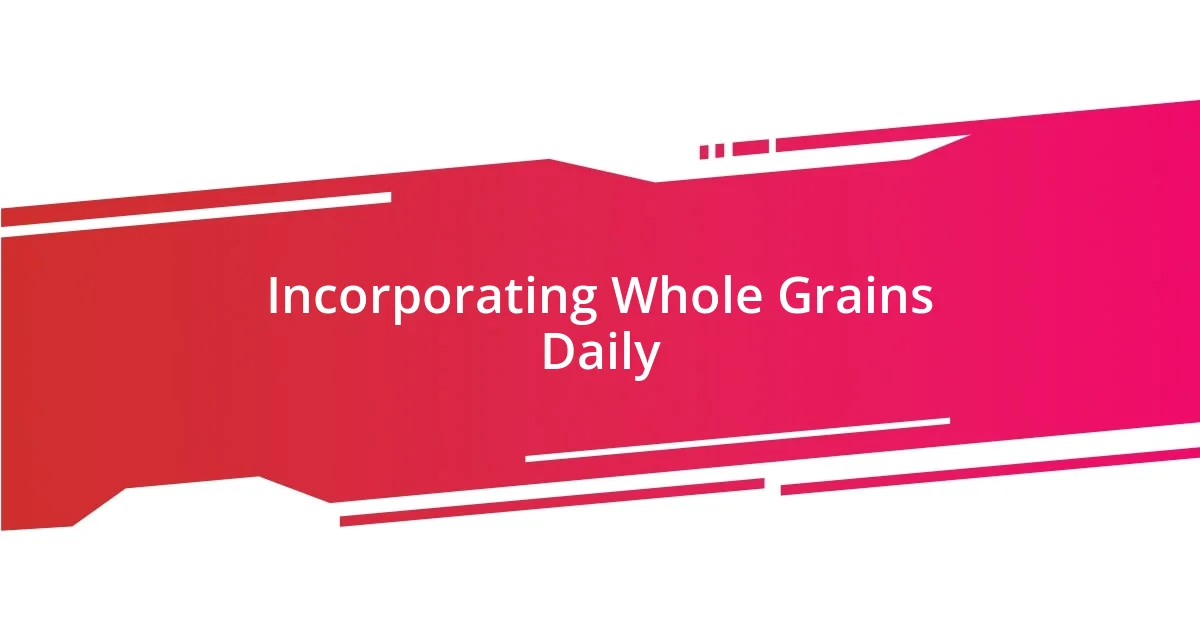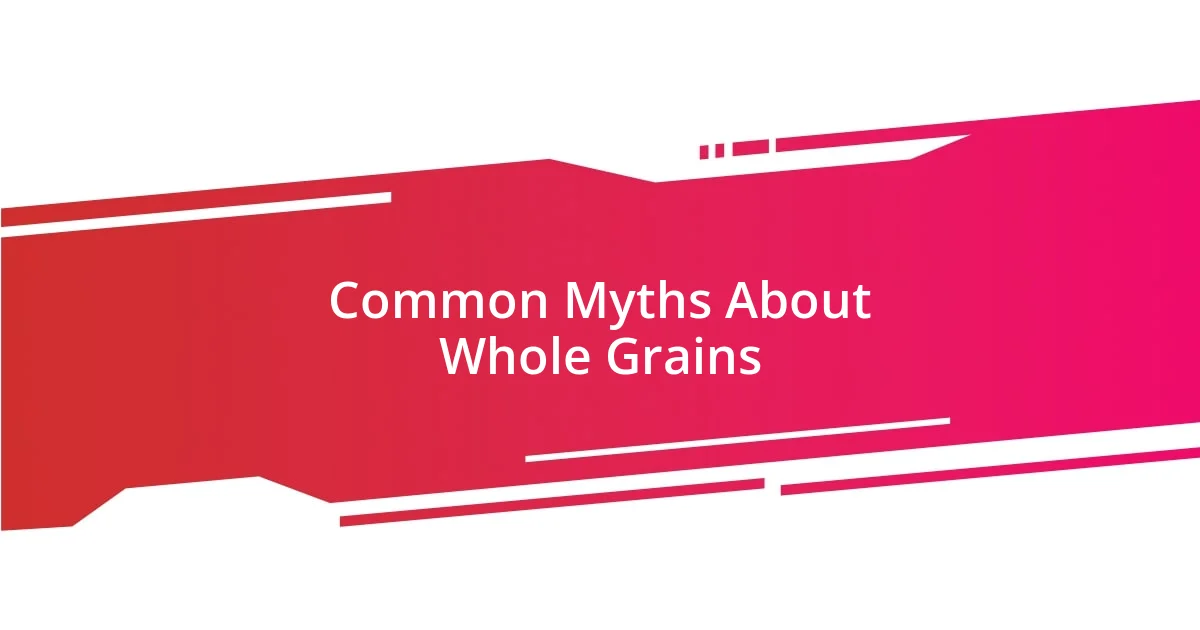Key takeaways:
- Whole grains contain all parts of the seed (bran, germ, endosperm) and provide greater nutritional value and satiety compared to refined grains.
- Incorporating whole grains into your diet can improve digestive health, increase energy levels, and lower the risk of heart disease and type 2 diabetes.
- Common whole grain snacks include crackers, popcorn, and oatmeal cookies, and it’s essential to read labels carefully to ensure products are genuinely whole grain.

Understanding Whole Grains
Whole grains are simply grains that contain all parts of the seed – the bran, germ, and endosperm. It’s incredible how this simple definition often gets overlooked. I remember a time when I thought “whole grain” just meant a healthier alternative, but it’s much more than that; it’s about embracing the nutritional power packed within those grains.
When I switched to whole grains, I felt a noticeable difference in my energy levels. Have you ever considered how much more filling they are compared to refined grains? I often find myself feeling satisfied longer, which helps curb those pesky cravings throughout the day. This shift not only keeps my hunger at bay but also introduces a range of nutrients that refined options simply lack.
Understanding the distinction between whole grains and their refined counterparts can be a game-changer for your diet. For instance, whole wheat bread retains its fiber and essential nutrients, whereas white bread loses much of its nutritional value during processing. I’d ask you to take a moment to evaluate your own pantry – what choices are you making? You might be surprised at just how much switching to whole grains can transform your meals and overall mindset towards food!

Health Benefits of Whole Grains
Whole grains provide an array of health benefits that often go unnoticed. One significant advantage is the abundance of fiber they offer, which plays a crucial role in digestive health. I’ve experienced firsthand how increased fiber intake can help me feel lighter and more energized. When I added oatmeal to my breakfast routine, not only did it keep me satiated until lunch but also improved my digestive comfort!
In addition to fiber, whole grains are rich in essential nutrients like B vitamins, iron, and magnesium. These nutrients are vital for energy production, and I can attest to this fact—in my busy days, when I make it a point to choose whole grains, I feel more alert and focused. I remember pulling an all-nighter for a project and reaching for whole grain crackers instead of bland chips. The difference in my ability to concentrate was striking!
Moreover, research shows that incorporating whole grains into your diet may reduce the risk of heart disease and type 2 diabetes. That really struck me when I thought about my family history of these conditions. It motivated me to swap my usual snacks for things like whole grain popcorn. It’s a small change that I take pride in—it feels empowering to take control of my health, one whole grain at a time.
| Health Benefits | Description |
|---|---|
| High in Fiber | Supports digestive health and keeps you full longer. |
| Nutrient Dense | Provides essential vitamins and minerals for energy and overall health. |
| Heart Health | May lower the risk of heart disease and type 2 diabetes. |

Types of Whole Grain Snacks
When exploring whole grain snacks, I find that variety is key to staying engaged. I often gravitate toward options that not only satisfy my cravings but also pack a nutritional punch. For instance, whole grain crackers have become a staple for me. They’re perfect with hummus or cheese, making for an enjoyable treat that fuels my day.
Here are some common types of whole grain snacks you might want to consider:
- Whole Grain Crackers: Great paired with dips or cheese.
- Popcorn: A fun, airy option that’s easy to customize.
- Whole Wheat Bread: A classic choice that can be transformed into sandwiches or toast.
- Granola Bars: Quick and convenient for on-the-go energy.
- Oatmeal Cookies: A delicious way to incorporate whole grains into dessert.
Finding these options has made my snacking enjoyable and nutritious—who knew a simple swap could be so fulfilling? I remember the first time I tried whole grain granola bars; the flavors were richer and more satisfying than the typical sugar-laden versions. It felt good knowing that I was choosing something that energized me rather than dragging me down. Just thinking about how these simple choices can boost my mood and well-being makes me enthusiastic!

Recipes for Whole Grain Snacks
One of my favorite whole grain snacks to make at home is homemade granola. It’s incredibly satisfying to combine rolled oats, nuts, and a little honey to create something truly delicious. When I first experimented with customizing my granola, I added dried fruits and a sprinkle of cinnamon. The aroma that filled my kitchen was heavenly! I remember a friend dropping by and being impressed with how easy it was to whip up a healthy snack that tasted indulgent.
Another go-to recipe for me is whole grain popcorn. I love popping it on the stove with just a drizzle of olive oil and some sea salt. The process feels almost nostalgic, bringing back memories of popcorn nights while watching movies with family. Have you ever tried adding spices like smoked paprika or nutritional yeast? It takes your snack to a whole new level! The burst of flavor always surprises me, making it hard to stop at just one handful.
If you’re looking for something sweet, I encourage you to try baking whole grain oatmeal cookies. Mixing in dark chocolate chips elevates the experience. I remember the first time I served these at a gathering; everyone raved about them! It was heartwarming to see friends enjoy what I made while knowing it was a healthier alternative to traditional cookies. Why not share the joy of healthy snacks with those you care about?

Incorporating Whole Grains Daily
Incorporating whole grains into my daily routine has made a noticeable difference in how I feel throughout the day. I often start my mornings with whole grain oatmeal topped with fresh fruit. It’s such a simple yet gratifying way to fuel my day. Have you ever experienced that comforting warmth of a bowl of oatmeal on a chilly morning? It creates an inviting start that sets a positive tone for my entire day.
Snack time is another perfect opportunity to include whole grains. I’ve found that swapping out my regular chips for whole grain popcorn satisfies my crunch cravings without the guilt. It’s become a delightful ritual for me—popping a fresh batch and sprinkling my favorite spices on top. I can’t help but smile every time I hear those kernels bursting—it’s a cheerful reminder of the joy small changes can bring.
When I make sandwiches, I always reach for whole wheat bread. It pleasantly surprised me how much heartier it is than white bread—and it’s more nourishing too! One afternoon, I prepared a simple turkey and avocado sandwich that turned out to be so filling and delicious that it changed my perspective on how to build my meals. I think about how easy it is to elevate even the most basic dishes with whole grains; it’s a fun way to experiment in the kitchen, don’t you agree?

Common Myths About Whole Grains
Many people believe that all whole grains are calorie-dense and should be avoided for weight management. However, my experience has shown me that when consumed in moderation, whole grains can actually contribute to satiety and help curb cravings. Have you ever noticed how a small serving of whole grain rice can be fulfilling? It’s all about understanding portion sizes and balancing your meals.
Another myth I encountered is that whole grain products are always less tasty than their refined counterparts. Personally, I was skeptical at first, but trying whole grain pasta changed my mind. It’s not just about health; the nutty flavor and chewy texture added an entirely new dimension to my favorite dishes. Why settle for bland when you can enjoy something healthier and tastier?
Lastly, many folks think all whole grain foods are the same. I used to think that if something was labeled “whole grain,” it was automatically good for me. However, on my journey to understand nutrition better, I’ve learned to check the actual ingredients. Brands often mix in refined flours or sugars, which dilutes the benefits of whole grains. So, I encourage you to read labels carefully—it’s an empowering step towards making healthier choices.















